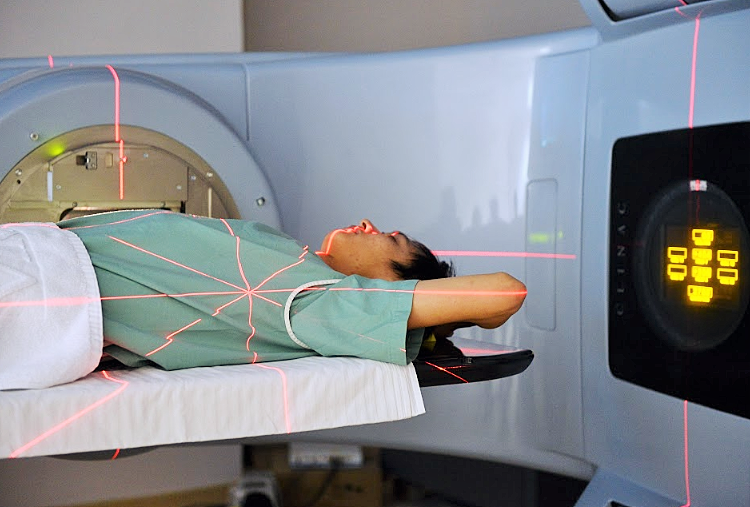Cervical cancer radiation therapy: What you need to know
The article was written by Specialist Doctor II Phung Thi Phuong Chi - Oncology Center, Vinmec Central Park International General Hospital.
Radiation therapy for cervical cancer is usually done in two stages. The first stage is external radiation therapy. Radiation delivered from outside the body, delivered to the entire pelvis to include pelvic lymph node areas, followed by radiation delivered internally, is called internal radiation therapy.
1. External radiation therapy
External radiation therapy can be understood in the same way as radiography, but with a higher dose of radiation. Each course of radiation therapy lasts only a few minutes, and even getting the patient into the treatment site takes longer. Radiation therapy does not cause pain.
When radiation therapy is used as the main treatment for cervical cancer, external radiation therapy is combined with chemotherapy (also called concurrent chemoradiotherapy), usually a small dose of the chemotherapy drug cisplatin. or some other chemotherapy drugs. Radiation therapy is usually given five days a week, for six to seven weeks. Chemotherapy drugs are given as scheduled infusions throughout the course of radiation therapy. The infusion schedule is arranged according to the type of drug used.
External radiation therapy can be performed separately to treat areas of metastatic cancer or as the main treatment when the patient is not able to receive chemotherapy and radiotherapy at the same time.
2. Possible side effects of external radiation therapy
Possible side effects of radiation therapy include: Fatigue Stomach pain Diarrhea or loose stools (when radiation therapy to the pelvis or abdomen) Nausea and vomiting Skin reactions: When radiation passes through skin to cancerous cells, it can destroy skin cells, causing mild irritation, short-term redness or peeling. The skin can secrete fluid, leading to infection, so the exposed skin should be cleaned and protected carefully. Radiation cystitis: Radiation to the pelvis can irritate the bladder, causing discomfort and frequent urination. Vaginal pain: Radiation can make the vulva and vagina sensitive and painful, and sometimes even discharge. Changes in menstrual cycle: Radiation can affect the ovaries, leading to menstrual changes, or even early menopause. Decreased blood factors: Anemia (decreased red blood cells) causing fatigue, a lack of red blood cells and an increased risk of serious infections are two of the examples of side effects of radiation therapy on blood factors. When chemotherapy is given with radiation therapy, blood factors tend to decrease more, fatigue and nausea also increase. These side effects usually improve within a few weeks after stopping therapy.
On the other hand, long-term side effects of external radiation therapy can also occur, which are listed below.

Mệt mỏi có thể là tác dụng phụ của ngoại xạ trị
3. Internal radiation therapy
Internal radiation therapy is a method of placing a radioactive source in or near the site of cancer, with radiation into the body for a short time. The most commonly used internal radiation therapy for cervical cancer is called intracavitary radiation therapy, where the radiation source is placed into a device in the vagina (sometimes in the cervix). It is used alongside external radiation therapy as part of the main treatment for cervical cancer.
There are two types of internal radiation therapy including:
Low dose radiotherapy is completed in a few days. During this time, the patient is confined to a single inpatient bed with equipment to keep the radioactive material in place. During treatment, medical staff will care for the patient, but also minimize radiation exposure for themselves. High-dose radiotherapy is an outpatient procedure performed in several sessions (usually at least one week apart). During each treatment, radioactive material is put in and out within a few minutes. The advantage of high-dose radiation therapy is that the patient does not need to be hospitalized or lie still for a long time. For patients who have had a hysterectomy, radioactive material is placed into a tubular device in the vagina.
For patients who still have a uterus, radioactive material will be placed in a small tube (tandem) and inserted into the uterus, with circular devices (ovoids) placed near the cervix. Another is called tandem and ring, with a circular gripper placed near the uterus. Depending on the type of pathology, internal radiation therapy is selected.
4. Short-term side effects of internal radiotherapy

Tác dụng phụ thường gặp khi xạ trị trong là kích ứng âm đạo, khi âm đạo bị đỏ và đau, có hoặc không dịch tiết ra
For internal radiation therapy, because the radiation is given for a short time, the main effects of the radiation are focused on the cervix and vaginal wall. The most common side effect is vaginal irritation, when the vagina is red and painful, with or without discharge. The vulva can also have the same problem.
Internal radiation therapy also causes many of the same side effects as external radiation therapy, such as fatigue, diarrhea, nausea, bladder irritation, and decreased blood factors. Often internal radiation therapy is given immediately after external radiation therapy, before the side effects subside, so it is difficult to know the cause of the side effect.
5. Long-term side effects of radiation therapy
Vaginal stricture: Both internal and external radiation therapy cause scarring of the vaginal tissue, which is the cause of vaginal narrowing, reduced elasticity or shortening of the vagina, causing pain during sex sex. Women can prevent this problem by dilating the vaginal wall several times a week, by having sex, or by using a vaginal dilator (a plastic or rubber tube inserted into the vagina that dilates the vagina). ).
Vaginal dryness: Vaginal dryness and pain during sex can be a long-term side effect of both internal and external radiation therapy. Topical estrogen helps to reduce vaginal dryness and changes in the lining of the vagina, especially when radiation to the pelvis destroys the ovaries causing early menopause. Typical hormonal therapy, such as topical application to the vagina and absorption into the vagina, comes in the form of gels, creams, rings, and suppositories, rather than oral administration. Weak bones: Radiation to the pelvis can weaken bones, leading to fractures. The most common is hip fracture, and can occur two to four years after radiation exposure. Patients are recommended to have a bone density test to monitor the risk of fracture. Swollen legs, one leg, or both: If the pelvic lymph nodes are treated with radiation, it can lead to drainage problems in the legs. This can cause lymphedema, which is severe swelling of the legs caused by fluid accumulation. Consult a medical professional if you experience any side effects from cancer treatment with radiation therapy.
Radiation therapy for cancer is a method that is widely used in medicine. Currently, Vinmec Central Park International General Hospital has successfully applied this method to treat many cancer cases, helping to reduce clinical symptoms and limit cancer metastasis.
Oncology Department at Vinmec Central Park is fully equipped with cancer treatment modalities: From surgery, radiation therapy, chemotherapy, radiation surgery .... pain treatment and palliative care. The diagnosis is made carefully: blood test, X-ray, ultrasound, magnetic resonance imaging, myelogram, myelogram, biopsy, immunohistochemistry, biological diagnosis molecule.
The treatment process is closely coordinated with many specialties: Center for Diagnostic Imaging, Laboratory Testing, Cardiology, Department of Obstetrics and Gynecology, Department of Endocrinology, Department of Rehabilitation, Department of Psychology, Department of Medicine. Nutrition, Pain Treatment and Palliative Care Department, in order to bring patients the optimal treatment regimen and the most reasonable cost.
Customers can go directly to Vinmec Central Park to visit or contact hotline 0283 6221 166, 0283 6221 188 for support.
Articles refer to the source of cancer.net
SEE MORE:
Notes when taking care of cancer patients with radiation therapy Recognizing side effects during radiation therapy for cancer of the abdomen and pelvis Psychological development of cancer patients by stage of disease
Bài viết này được viết cho người đọc tại Sài Gòn, Hà Nội, Hồ Chí Minh, Phú Quốc, Nha Trang, Hạ Long, Hải Phòng, Đà Nẵng.






